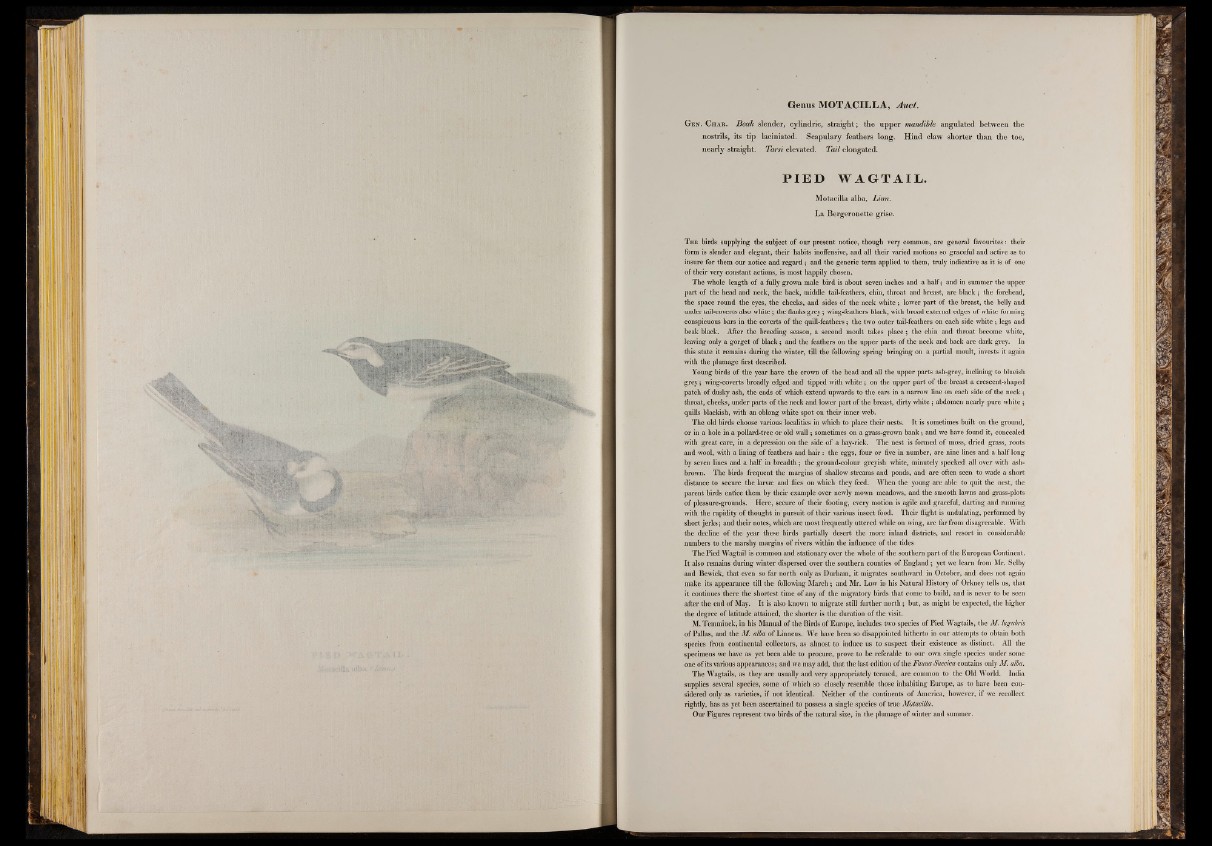
IHj
Gen. Char. Beak slender, cylindric, straight; the upper mandible angulated between the
nostrils, its tip laciniated. Scapulary feathers long. Hind claw shorter than the toe,
nearly straight. Tarsi elevated. Tail elongated.
P I E D WA G T A I L .
Motacilla alba, Linn.
La Bergeronette grise.
T h e birds supplying the subject of our present notice, though very common, are general favourites: their
form is slender and elegant, their habits inoffensive, and all their varied motions so graceful and active as to
insure for them our notice and regard; and the generic term applied to them, truly indicative as it is of one
of their very constant actions, is most happily chosen.
The whole length of a fully grown male bird is about seven inches and a half; and in summer the upper
part of the head and neck, the back, middle tail-feathers, chin, throat and breast, are black ; the forehead,
the space round the eyes, the cheeks, and sides of the neck white ; lower part of the breast, the belly and
under tail-coverts also white; the flanks grey; wing-feathers black, with broad external edges of white forming
conspicuous bars in the coverts of the quill-feathers; the two outer tail-feathers on each side white; legs and
beak black. After the breeding season, a second moult takes place; tbe chin and throat become white,
leaving only a gorget of black; and the feathers on the upper parts of the neck and back are dark grey. In
this state it remains during the winter, till the following spring bringing on a partial moult, invests it again
with the plumage first described.
Young birds of the year have the crown of the head and all the upper parts ash-grey, inclining to blueish
grey; wing-coverts broadly edged and tipped with white ; on the upper part of the breast a crescent-shaped
patch of dusky ash, the ends of which extend upwards to the ears in a narrow line on each side of the neck ;
throat, cheeks, under parts of the neck and lower part of the breast, dirty white; abdomen nearly pure white ;
quills blackish, with an oblong white spot on their inner web.
The old birds choose various localities in which to place their nests. It is sometimes built on the ground,
or in a hole in a pollard-tree or old wall; sometimes on a grass-grown bank; and we have found it, concealed
with great care, in a depression on the side of a hay-rick. The nest is formed of moss, dried grass, roots
and wool, with a lining of feathers and hair: the eggs, four or five in number, are nine lines and a half long
by seven lines and a half in breadth; the ground-colour greyish white, minutely specked all oyer with ash-
brown. The birds frequent the margins of shallow streams and ponds, and are often seen to wade a short
distance to secure the larvae and flies on which they feed. When the young are able to quit the nest, the
parent birds entice them by their example over newly mown meadows, and the smooth lawns and grass-plots
of pleasure-grounds. Here, secure of their footing, every motion is agile and graceful, darting and running
with the rapidity of thought in pursuit of their various insect food. Their flight is undulating, performed by
short jerks; and their notes, which are most frequently uttered while on wing, are far from disagreeable. With
the decline of the year these birds partially desert the more inland districts, and resort in considerable
numbers to the marshy margins of rivers within the influence of the tides.
The Pied Wagtail is common and stationary over the whole of the southern part of the European Continent.
It also remains during winter dispersed over the southern counties of England; yet we learn from Mr. Selby
and Bewick, that even so far north only as Durham, it migrates southward in October, and does not again
make its appearance till the following March; and Mr. Low in his Natural History of Orkney tells us, that
it continues there the shortest time of any of the migratory birds that come to build, and is never to be seen
after the end of May. It is also known to migrate still further north; but, as might be expected, the higher
the degree of latitude attained, the shorter is the duration of the visit.
M. Temminck, in his Manual of the Birds of Europe, includes two species of Pied Wagtails, the M. lugubris
of Pallas, and the M. alba of Linneus. We have been so disappointed hitherto in our attempts to obtain both
species from continental collectors, as almost to induce us to suspect their existence as distinct. All the
specimens we have as yet been able to procure, prove to be referable to our own single species under some
one of its various appearances; and we may add, that the last edition of the Fauna Suecica contains only M. alba.
The Wagtails, as they are usually and very appropriately termed, are common to the Old World. India
supplies several species, some of which so closely resemble those inhabiting Europe, as to have been considered
only as varieties, if not identical. Neither of the continents of America, however, if we recollect
rightly, has as yet been ascertained to possess a single species of true Motacilla.
Our Figures represent two birds of the natural size, in the plumage of winter and summer.